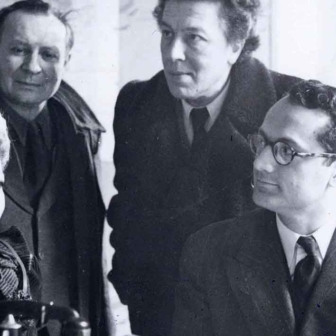Seven Ways to Kill a Cat
By Matías Néspolo | Translated by Frank Wynne | Harvill Secker | $34.95
Seven Ways to Kill a Cat begins in mock pedagogic mode, with Chueco preparing to give his friend Gringo a practical demonstration of the novel’s title. “There’s seven ways to kill a cat,” Chueco announces, but he quickly narrows the lesson down to the two ways that really count: you can kill a cat, he tells Gringo as he breaks the animal’s neck, “in a civilised fashion, or like a fucking savage.” Chueco’s preferred method of despatch is, we learn, the civilised one. We are left to imagine the savage version, but we’re also left to understand that it’s a fine line between the two. It’s this line, between the civilised and the savage, that forms the basis of Matías Néspolo’s sharp and snappy first novel.
Originally published in 2009, Seven Ways to Kill a Cat earned Néspolo a place the following year on Granta magazine’s list of the Best of Young Spanish-Language Novelists and is now available in English in an energetic translation by Frank Wynne. The novel is narrated by Gringo, who tells the story of his own and Chueco’s struggle to survive in the slums of Buenos Aires, navigating the violence all round while dodging for as long as possible the fate of the cat. We’re at the very beginning of the twenty-first century and the Argentinean economy has collapsed. Money has taken on an unreal, cartoon-like quality, food is scarce and what little rice Gringo can get hold of has weevils in it. As for the cat, it is destined to be dinner.
Cats and weevils are part of a large supporting cast of non-humans that includes all manner of bugs and insects, as well as dogs and rats and weasels and, rather less predictably, two whales. One of the whales is the Moby Dick of Melville’s novel and the other is Josephina, the star of the Japanese cartoon series that Gringo remembers seeing as a child. Moby Dick makes multiple appearances, but Josephina receives only a passing nod, yet of all the animals and insects that get a mention, she is the only one whose presence is essentially benign. Gringo admires Josephina the whale for her ability to shrink down to the size of a drop of water, or to get bigger again and to “fly off with a little boy” on her back. But neither invisibility nor escape is an option for Gringo, who is trapped by the slums and constrained by a plot that drags him along against his will.
Like the civilised and the savage, animals and humans overlap in the novel to the point where it becomes difficult to tell them apart. “There’s a dark shape in the middle of the road in a pool of blood that keeps spreading,” says Gringo. He’s a long way away and he can’t quite make it out, but after a while he realises that it’s got too much hair to be a child. “It’s a dog,” he says. In similar fashion, Gringo frequently recognises himself as an animal. He prowls around like a cat in a cage. He’s a rat on the run; “all I need is a tail and I’d be one of them.” As he gets caught up in a war between rival gangs, his only possibility of escape is to communicate with his friend Quique by imitating the call of a “non-existent bird.”
With a few exceptions – like Josephina, or Quique’s dog Sultán, the one whose body Gringo has initially mistaken for that of a child – the animals in Seven Ways to Kill a Cat are typically nameless and always dispensable. And it is much the same with the people. They do go by names, but generally not their real ones. “There’s no point getting bent out of shape about names,” says Gringo, whose nickname comes from his blond colouring. Even his beloved Mamina isn’t really his grandmother. She is just somebody who took him in, and by the time of the novel’s action, when Gringo is twenty, she is already preparing to let him go again.
In a recent interview Néspolo described Argentinean writing as cannibalistic, an observation he traces back to Borges and to a continuing process of “ingesting and metabolising other cultures and literatures that has come to define Argentina’s identity.” Seven Ways to Kill a Cat is full of such self-conscious references to these “other cultures” – to gangster flicks, for example, or Hollywood westerns – and to ingrained habits of imitation. “He’s acting his part,” says Gringo of Chueco when his friend starts getting carried away with his own belligerence: “all he needs is a film crew.” Poor Chueco. “For all his gangster posing, he obviously hasn’t a fucking clue.”
Early on in the novel, Gringo gets hold of a copy of Moby Dick, which he then carries around with him as a kind of talisman, dipping into it during lulls in the action. The implausibility of this device is part of the point, suggesting as it does the gap between a literary classic from another world and Gringo’s own high-stakes preoccupation with survival. Just as Gringo looks foreign but isn’t, so Néspolo’s novel appears to defer to “other cultures and literatures” while at the same time making a firm, even belligerent, distinction between the foreign and the home-grown. “How’s it going with the whale?” asks Piti, a friend of Gringo’s cousin and another character who is susceptible to bouts of pedagogical excess, “waving his cigarette like a pointer, like he’s some professor.” Piti explains to Gringo about the human condition and the nature of metaphor and what the whale in Moby Dick represents, but Gringo is not impressed. “Metaphor my arse,” he says.
Néspolo is tackling that most difficult of novelistic tasks, how to capture the quality of uniqueness – of originality – that lies beneath a surface of cultural deference and imitation. Translation further compounds the problem. Should we as readers be looking for the spark of cultural difference in translated fiction, the qualities that make a novel still recognisably Argentinean, for example, or is it all about the universality of experience, a globalised take on a globalised world? Translation, once a near invisible profession, has moved closer to the spotlight in recent years partly because of the increasing importance of these questions; on the one hand there are the connections across cultures and experiences that translation can highlight, and on the other there is the need to preserve that quality of difference, thereby discouraging the reader from simply transposing the life of a novel set in Argentina or Azerbaijan to somewhere closer to home.
Frank Wynne touches on these questions in his Translator’s Note at the beginning of Seven Ways to Kill a Cat. “Since I could not imagine Gringo addressing his friends as ‘mate,’ ‘buddy,’ ‘bro’ or ‘brah,’ I borrowed from Spanish the many words for friend – socio (partner), loco (madman), viejo (old friend), compañero (comrade), pibe (kid) and the ubiquitous Argentinean interjection che (which can translate as ‘man’ or simply as ‘hey!’).” Another of Néspolo’s translators, Beth Fowler, who won the 2010 Harvill Secker Young Translators’ Prize with her version into English of his short story “The Axe Falls,” puts the problem in terms of “what to do with items of food and drink such as quesillos or mate which have no direct translation.” One possibility is to “turn them into a cheese sarnie and a cuppa,” but clearly that won’t do. Like Wynne, Fowler opts for leaving these culturally specific terms untranslated. Sometimes there is just no substitute for the original. •




